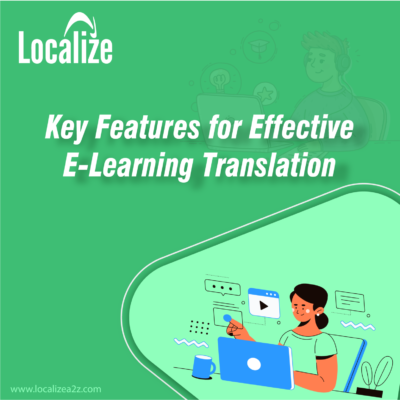
E-learning has revolutionized the way we learn and acquire knowledge. With the rise of e-learning platforms, the need for effective translation of e-learning content has become crucial to ensure accessibility
and comprehension for a diverse, global audience. Effective e-learning translation involves more than just converting words from one language to another. It requires careful consideration of various features to guarantee a seamless and impactful learning experience in multiple languages. Here are the key features for achieving effective e-learning translation:
1. Contextual Understanding:
Translators must possess a deep understanding of the context of e-learning content. This includes the subject matter, target audience, learning objectives, and the overall structure of the course. A good grasp of the context ensures accurate and relevant translation.
2. Adaptation and Localization:
Adaptation goes beyond translation, involving the localization of content to suit the target culture, including idiomatic expressions, cultural references, and even images that resonate with the local audience. It’s about making the content relatable and culturally appropriate.
3. Multilingual Team Collaboration:
Collaboration among a team of translators, subject matter experts, and instructional designers is essential. Bringing together a diverse group of professionals ensures accurate translation, content coherence, and alignment with educational goals.
4. Consistency in Terminology:
Maintaining consistent terminology across the e-learning content is crucial for comprehension. Developing a glossary of key terms in multiple languages ensures uniformity and clarity of concepts for the learners.
5. Integration of Visual Elements:
Translate and localize not only the text but also visual elements such as images, diagrams, charts, and videos. Ensure that these visuals are culturally appropriate and support the understanding of the content in the target language.
6. Accessibility Considerations:
Consider accessibility standards for differently-abled learners during the translation process. Ensure that the translated content is compatible with screen readers and other assistive technologies for a broader audience reach.
7. Adherence to Learning Objectives:
The translated content should align with the original learning objectives, maintaining the intended instructional outcomes. This requires careful translation that preserves the instructional integrity and purpose of the course.
8. Interactive Element Translation:
Translate interactive elements like quizzes, assessments, and simulations accurately. Ensure that the learner’s engagement and interactivity remain intact, promoting an immersive learning experience.
9. Quality Assurance and Testing:
Implement a rigorous quality assurance process, including proofreading and testing the translated e-learning modules. Thorough testing helps identify and rectify any language or functionality-related issues, ensuring a seamless user experience.
10. Feedback and Iteration:
Encourage feedback from learners who have accessed the translated content. Gather insights into their learning experience, language comprehension, and cultural relevance. Use this feedback to iterate and improve future translations.
Effective e-learning translation is a nuanced and multifaceted process that demands careful consideration of context, cultural adaptation, visual elements, and interactivity. To make e-learning accessible and impactful for a global audience, invest in a comprehensive and collaborative translation approach that upholds the original learning objectives while catering to diverse linguistic and cultural backgrounds. By prioritizing these key features, e-learning platforms can ensure that their educational content is inclusive, informative, and transformative for learners worldwide. To know more about e-learning translation contact Localize a2z